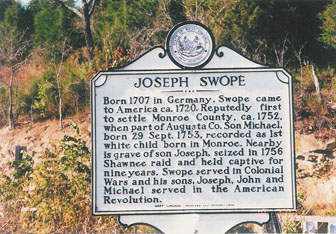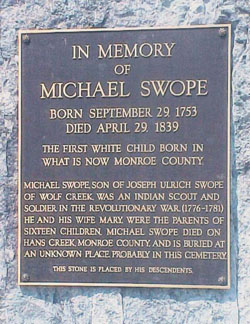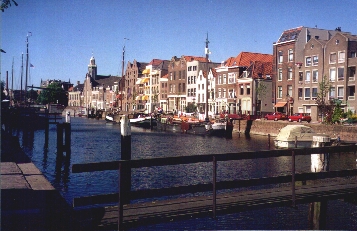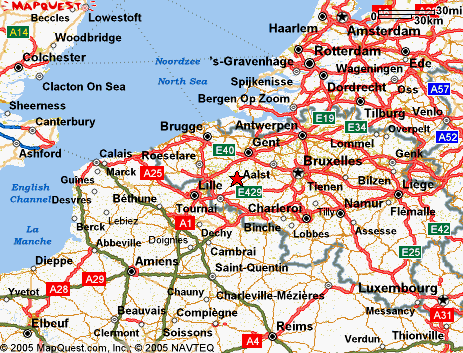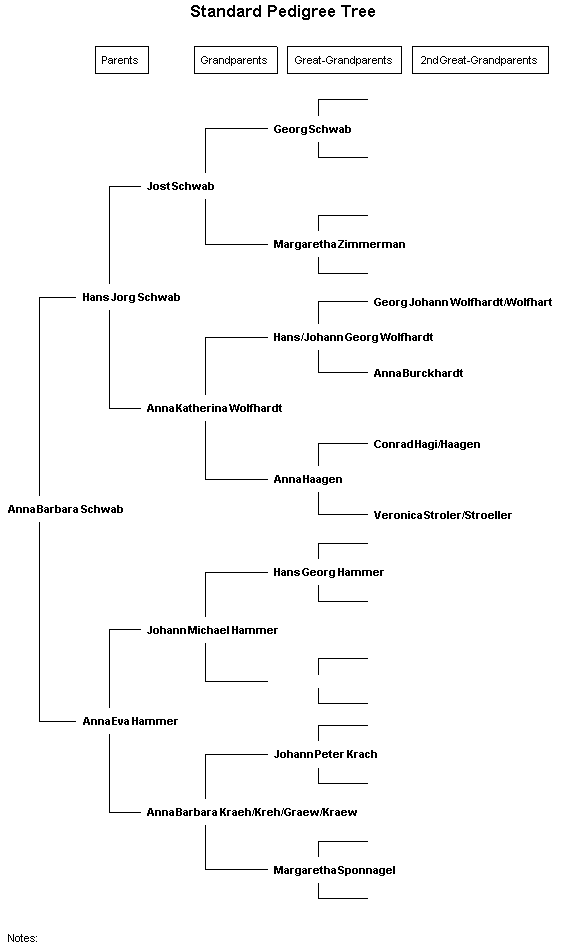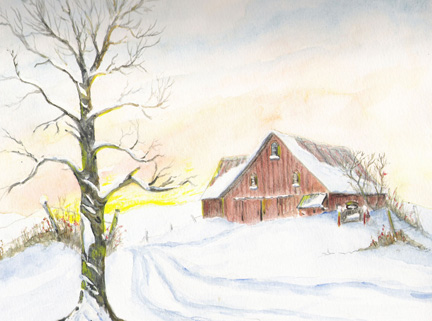|
Ranck & Swope Genealogy
|
|||||||||||||||||||
|
Descendants of Jean Valentine Ranc Generation No. 1 1. Jean Valentine1 Ranc was born 1641 in Paris, France, and died 1712 in Mannheim, Baden, Germany. Notes for Jean Valentine Ranc: info on Rank family from "The Ranks of the Rancks," by J. Allan Ranck, 1978; from family web site www.ranck.org; researcher Steve Kaminiski, skamm@occc.edu, at RootsWeb's WorldConnect Project, who sites the above as well as "Ancestors of Henry Harrison Fackler," and "Descendants of Jean Valentine Ranc Repository," LDS. from "The Ranks of the Rancks" at Ranck family web site: 'In 1641 in the middle of this period of relative calm created by the edict of Nantes, Jean Ranc, the Huguenot pastor from Paris, was born. We do not know the names of his parents nor the links which tie him to the Vibrac lineage. It is assumed that his roots were in that Languedoc soil. Nor do we know the name of his wife. Their only son was named Hans Valentine, a spelling which appears to reflect the transition from French to German through which the family moved in the succeeding troublesome decades. In France, the name would probably have been Jean Valentin. 'When in 1685 King Louis XIV revoked the edict of Nantes and resumed the unbridled persecution of Protestants, ordering all Huguenot clergymen to leave France in fourteen days, Rev. Jean Ranc, then forty four years of age, fled with his family from Paris to escape the death which would undoubtedly have been their lot. 'The Elector Frederick of the Palatinate successfully withstood the frequent efforts of the french to penetrate his province and established it as a refuge for the Protestant exiles. Mannheim, not yet a large city, became a Huguenot center and Jean Ranc no doubt continued his preaching there. Son Hans Valentine met in Mannheim and married Margaretha Philippes (Mafgarith Philipp) of French-Dutch descent. They had six children: Anna Barbara, John Michael, John Philip, Rosine Katharine, Susanna Margaretha and Johann Valentine born in 1699, 1701, 1704, 1705, 1707, and 1710 respectively. Hans Valentine died in 1710 leaving his young family in the care of their grandfather. Only two years later Rev. Jean Ranc also died. Rosine Katharine and Johann Valentine died in childhood. The remaining four children, left with their mother, grew to young adulthood in Mannheim. Our family story continues in the lives of the two brothers. John Michael and John Philip. Of their mother and the other children we have no further knowledge, except that on 26 February 1725 Susanna Margaretha married Johann Valentin Weinkraus." [in 1996, it was discovered that Christian Schneder, his wife Susanna Margaretha Ranck, and their daughter Margaret arrived in Philadelphia September 11, 1729 aboard the ship Allen, settled originally in Weaverland and later resettled on 133 acres purchased from Penn's sons south of present Terre Hill.] from Steve Kaminiski: " J. Allen Ranck...points out that 'this family spelled their names variously at various times and places--Ranc, Rance, Rank, Ranck, Ranke, Ronk and perhaps Runk.' He also says that the story of this family begins in medieval France and Germany, possibly even in Spain. "When the persecution of the Huguenots resumed with bitter vengeance, La Rochelle no longer existed as a haven and there was little political or military power to restrain the vengeful King. Rev. Jean Ranc, with his wife and son Hans Valentine, fled first to the Alsatian city of Strasburg on the Rhine. It was not long until the armies of Louis recaptured that city, which throughout its history was sometimes German and sometimes French territory. The refugees had to flee even farther down the Rhine to Mannheim. The Rev. died in Mannheim. There is some validity to connect him with Bernadin du Ranc, Seigneur de Vibrac but it is impossible to make a direct connection other than to suggest that he was the younger son, cadet, who did not inherit the title. "Ancestry has been traced to Bernadin Du Ranc, Baron of Vibrac, which died out in 1820 in Sommieres with Jean Louis Du Ranc. The estate of Vibrac had been raised to a Barony in 1620 A.D. M le Baron Jean Louis Rance was the last member of the family to own the Chateau de Vibrac. The Chateau still stands, partially occupied and partially in disrepair, in the Province of Vibrac not far from Montpelier in southern France, near the small village called Durfort.
" During the period of turmoil and religious persecution many members of the Ranc family were caught up in the French Protestant Movement with leanings towards the Huguenots. Persecution during this period resulted in violent death for tens of thousand of people and scattered refugees from France and Germany into Holland and many other places of refuge. [He fled France with his family in 1685,when King Louis XIV, revoked the Edict of Nantes, and resumed the persecution of protestants, ordering all Huguenot clergymen, to leave France in fourteen days.] "Reverend Jean Ranc with his wife and son, Valentine, fled first to the city of Strasburg on the Rhine. Later they fled farther down the Rhine to Mannheim which was in the area of Germany called 'Palatinate.' From this province many immigrants came to America in the 18th century.' " Child of Jean Valentine Ranc is: 2 i. Hans Valentine2 Ranck, born 1668 in Mannheim, Baden, Germany. He married Margaretha Philippes; born October 19, 1670 in Mannheim, Baden, Germany.
Generation No. 2 2. Hans Valentine2 Ranck (Jean Valentine Ranc) was born in 1668 in Mannheim, Baden, Germany, the son of Reverend Jean Ranc. He married Margaretha Philippe, who was born October 19, 1670, in Mannheim, Baden, Germany, the daughter of Henry Philippes, born about 1644, and Marguerite Weinkraus, born about 1648..
Notes for Hans Valentine Ranck: from Steve Kaminiski:
Child of Hans Ranck and Margaretha Philippe is: + 2 i. John Michael2 Ranck, born October 28, 1701 in Neckarau, near Mannheim, Baden, Germany; died July 28, 1778 in Lancaster Co., PA. 2 ii. John Philip Ranck. He married Anna Barbara Schumacker. Generation No. 3
***For Schwab/Swope genealogy, go to the bottom of this page.*** Notes for John Michael Ranck: from "The Ranks of the Rancks," by J. Allen Ranck,
1978:
From the Ranck family website, ranck.org, "The treasure of the Ranck Clan is the John Michael Ranck family Bible which passed through Louisa Ranck Steffey, grandaughter of Valentine, and thence to E. Louella Hershey Nolt. It was purchased by the Ranck Clan at an auction at the Lancaster Mennonite Historical Society in October 1995." 'Nature itself treated these new colonists
harshly, we are told. Frank R. Diffenderffer, in "The Three Earls [New
Holland, Ranck, and Sandoe, 1876] catalogues the following hardships: a
plague of locusts in 1732; and earthquake in 1737; prostrating heat in the
summer of 1738; bitter winters of 1740 and 1741; a drought from 1753 to
1755; and the famous "Hard Winter" of 1780 when ice on the ponds became
twenty inches thick! From the Ranck family website, at right is a map of the land owned by the Ranck family, John Michael and later by his relatives and descendants. This is east of New Holland, Lancaster Co., PA.
Above is a modern map of the townships in Lancaster Co., PA. New Holland is up and right of center. Below is a modern map showing, in green outline, the original Ranck farms east of New Holland, Lancaster Co., PA.
from 'Burial Book of the Moravian Church, Lancaster, 1744-1821,'
"The Pennsylvania Magazine of History and Biography," vol. I, Genealogical
Publishing Co., Inc., Baltimore, MD. 1983, pp. 398-399: from "The Swope Family Book of Remembrance" by Morse & McLachlin: 'Four daughters and their husbands are named in the will of George Swoope (Hans Jorg Schwab) of Paradise Township, York County, Pennsylvania. The eldest daughter, Anna Barbara, born about 1708, married John Michael Ranck, born 28 October 1701 in Neckarau near Mannheim in Baden, Germany, the son of Hans Valentine Ranck and Margaretha Philippe. John Michael Ranck arrived in Philadelphia, 24 August 1728 on board the ship "Mortonhouse." He died in Lancaster County, Pennsylvania the 28th of July 1778; Anna Barbara died in 1784. They had the following children: George Michael Ranck went to Survey County, North Carolina; John Ranck went to Survey County, North Carolina; Philip Ranck, born 1734 married Barbara Stauffer, 10 August 1763. They had nine children... Valentine Ranck, born 1 October 1747, died 16 March 1839, married Barbara Geyer, 9 April 1780... Samuel Ranck, Born 30 July 1742, died 22 May 1815, married Maria Salome and ...Margaret Kleinman... Samuel Ranck, Sr. crossed the Delaware with General Washington Christmas night 1776. Margaret Ranck married Philip Grosh... Barbara Ranck married Jacob Stiegelman... Christina Ranck married Wendel (?) Fockler. Their children were George Fockler, Barbara, Elizabeth, Eva, Christina, Abraham, Samuel and Wendel Fockler. Anna Maria Ranck...married Rev. Christopher Grosh. Eva Elisabeth Schwab...married Peter Jager/Yeager...'
Notes for Anna Barbara Schwab: from "The Swope Family Book of Remembrance" by Morse & McLachlin: 'Four daughters and their husbands are named in the will of George Swope (Hans Jorg Schwab) of Paradise Township, York County, Pennsylvania. The eldest daughter, Anna Barbara, born about 1708, married John Michael Ranck, born 28 October 1701 in Neckarau near Mannheim in Baden, Germany, the son of Hans Valentine Ranck and Margaretha Philippe. John Michael Ranck arrived in Philadelphia, 24 August 1728 on board the ship "Mortonhouse." He died in Lancaster County, Pennsylvania the 28th of July 1778; Anna Barbara died in 1784." **For more information on the Swope/Schwab genealogy, go to the bottom of the page.** Children of John Michael Ranck and Anna Schwab are: + 3 i. Christina "Anna"3 Ranck, born May 21, 1745; died Abt. 1807 in Dauphin Co., PA. 4 ii. George Michael Ranck. More About George Michael Ranck: Fact 1: went to Survey County, North Carolina; 5 iii. John Ranck. More About John Ranck: Fact 1: went to Survey County, North Carolina; + 6 iv. Philip Ranck, born 1734. 7 v. Samuel Ranck, born July 30, 1742; died May 22, 1815. He married Margaret Kleinman. More About Samuel Ranck: Fact 1: "crossed the Delaware with General Washington Christmas night 1776"; + 8 vi. Margaret Ranck. + 9 vii. Barbara Ranck. + 10 viii. Anna Maria Ranck, born December 25, 1750 in Lancaster Co., PA; died January 04, 1837. + 11 ix. Valentine Ranck, born October 01, 1747; died March 17, 1839.
Generation No. 4
4. Christina "Anna"4 Ranck (John Michael3, Hans Valentine2, Jean Valentine Ranc)was born May 21, 1745, and died Abt. 1807 in Dauphin Co., PA. She married Johann Wendel Fackler. He was born Abt. 1746, and died Abt. 1823 in Dauphin Co., PA. Notes for Christina "Anna" Ranck: from "The Swope Family Book of Remembrance" by Morse & McLachlin: 'Christina Ranck married Wendel (?) Fockler. Their children were George Fockler, Barbara, Elizabeth, Eva, Christiana, Abraham, Samuel and Wendel Fockler.' Notes for Johann Wendel Fackler: info from "Pennsylvania German Ancestors of the Hiram and Irene Frysinger Family," draft by Dr. Anne Shifflet, Bear Den Rd., Frederick, MD; also from Pennsylvania German Pioneers, vol I, by Pennsylvania German Society, 1934; also from Fackler researcher Harry C. Fackler at RootsWeb.com; name also spelled Fachler, Fockler, Fochler, Fakler, Falkler, Faukler, Falkner, Fagler; from "Pennsylvania German Ancestors of..." by Dr. Shifflet: 'Johann Wendel Fackler sailed from Rotterdam to America on the ship Chance. He registered at the state house in Philadelphia on November 1, 1763. Various researchers have stated that Joh. Wendel Fackler was born in 1746; however, no primary source for documenting that information has been provided.' from footnote to above: 'Oral tradition created this wonderful tale, told by a descendant in Ohio, which may contain kernels of truth, but contradicts many of the known facts: ...Wentle (sic) Fackler, whose birth occurred in Germany in 1746. Spending the first seventeen years of his life in the fatherland, he afterward came to America and was sold or apprenticed on the streets of Philadelphia for three years in order to pay his passage. When the time had half expired, however, he was released by his master and employed at regular rates of labor. Two years later he returned to his native country for his mother and two brothers, his father in the meantime having been killed in battle. After he had again come to America, Wentle Fackler joined the colonists in their struggle for independence, serving under Washington during the memorable winter at Valley Forge, and meeting the troops of Burgoyne in the north and Cornwallis in the south. When the republic was established he purchased a tract of land from the government, and cut timber from which he built a house. He married Anna Rank and they became parents of ten children. Wentle Fackler, who was a devout member of the Presbyterian Church, lived to enjoy the fruits of liberty many years and passed away in 1823.' This family tradition, told by Tillie Fackler, was recorded in the "History of Richland County, Ohio." Quoted in Forest D. Myers and Jerry A. Clouse, "Briner Family History" (Harrisburg, 1984), p. 110.' 'Wendel presumably was living in Earl Township in 1767 when he and his wife Christina Ranck had a son George baptized in the Seltenriech Reformed Church near New Holland. 'By 1770, Wendel was living in Paxton Township. In 1770 and 1771, he was taxed there as an "inmate," along with Adam Fockler. On May 16, 1771, Wendel and Christine entered into a mortgage agreement for 300 pounds with Jacob Miller. Collateral was "about 100 acres" of land in Paxton Township. Several undated tax returns of Paxton Township, believed to be from the 1770s, and the 1779 returns listed Vendle Fackler, taxed on 80 acres, 50 acres cleared land, 2 horses, 2 cows, 6 sheep. 'In August of 1777, Wendel was assessed a special tax of L3.6 imposed on "non-associators." A non-associator was one who chose not to participate in the military training and exercises for civilian reserves. At the beginning of 1775, Pennsylvania, founded under Quaker auspices, was totally devoid of military organization. As tensions with England mounted, volunteer companies of "Associators" formed a civilian reserve. On 30 Jun 1775, the Provincial Assembly gave official recognition to the Associators and grouped the Associators into township groups, with several township groups formed into a battalion. Although these Associators were volunteers, as the struggle became bitter, men who refused to volunteer were termed "non-associators" and were fined and punished in other ways. 'In order to assure support for the struggle for independence, the Supreme Executive Council of Pennsylvania decided on 13 Jun 1777 that every white male over the age of 18, with no exceptions, should be required to make a public commitment to support the state of Pennsylvania, and renounce allegiance to George the Third, King of England. Within three weeks, before July 1, all the men, were to appear before a justice of the peace and swear to or affirm the Oath of Allegiance. The deadline was later extended to 1 Jun 78. Wendel's name was not listed among those who took the oath in Lancaster County during 1777 and 1778. 'Wendel was not charged a double tax in 1779 as some others were. However, in 1780 and 1781, he paid twice the amount of his property tax as a fine for "those not yet sworn." In 1780, Wendle Fackler was named on "A List of all Male white Persons Residing in the Bounds of Captain Hugh Robinson's Company Between the Ages of Eighteen and Fifty-three years, Being the Fourth Company of the Tenth Battalion of Lancaster County Militia." 'These indications of refusal to give oath and non-participation in military activities suggest the influence of the German Baptist Brethren faith. Because no membership lists were kept, it is not known when Wendle became associated with the Brethren. However, several of Wendel and Christina's children married sons and daughters of the early leaders of the Big Swatara congregation. 'On 8 Jun 1779, Wendle and Christina had acquired additional "land situate and lying on Beaver Creek part in Paxton Township and part in Hanover Township (being the tract of land granted by the late Proprietor of Pennsylvania by therr warrant dated the Eight of June 1774 unto a certain Jacob Steigleman)..." Jacob Steigleman was the husband of Christina's sister Barbara Ranck. 'On 25 Jul 1784, Wendel purchased another 250 acres of land along Beaver Creek from Abram and Susannah Eagly. Wendel Fackler's name continued to appear on the Paxton Township tax lists, and after 1785, when Dauphin County was formed, on the Lower Paxton lists until his death. His name, however, was not found on the first United States census in 1790. This may have been on oversight, but, more likely, was due to his request that his name not be listed. Many were suspicious of the intent of the census. 'From the records of the assessors for the 1798 Federal "window tax" we learn that Wendel's family was living in a one-story log home, 22' X 44', a stable was 25' square, and a 15' X 18' weaver's shop was also on the farm. 'Wendel and Christina sold the 20 acres of their land across the Beaver Creek in West Hanover Township to Philip Overcast on 17 Apr 1798. The 1800 Census listed Vendle Fackler and his wife as over 45 years of age, and with three boys and three girls in the household, all between the ages of 16 and 25. 'Wendel obtained the patent on 3 Mar 1803 for his farm, the "Hamburg"tract which he had purchased in 1784. On 26 Nov 1805, he purchased 156 acres of land a few miles from his home (near Susquehanna Township line). 'This was to begin a time of consolidation and regrouping in Wendel's life, a time of concern for the future of his family. It is believed that Christina died about 1805. 'The farm which Wendel had purchased in 1805 was sold to his son Abraham on 5 Aug 1807. A few weeks later, on 27 Aug 1807, he signed a marital agreement provided to care for his new wife Catharine, the widow of Jacob Zeiger... 'Wendel sold his original farm, the "Springfield" tract, and 24 additional acres, to his son-in-law John Brehm, on 22 Nov 1809... A few days later on 27 Nov 1809, on 27 Nov 1809, Wendel finalized the sale of the remaining 105 acres of the "Hamburg" tract along the beaver Creek to his son Wendel... 'In the 1810 census, Wendle and his wife were listed as over 45, with one boy and one girl between 16 and 25 in their household. Having divested himself of his land holdings, Wendel's tax assessment in 1810 was slashed from $8.50 to .50. The next year Wendel Fackler, Sr., was listed as a tenant.
The counties of Pennsylvania in 1791, Dauphin County, where Wendel Fackler died in 1814, is outlined in green, lower right. Dauphine County was formed from Lancaster County in mid 18th century. Just south of Dauphine is Lancaster County, outlined in blue. The area of these two counties is where the families of Ranck, Swope, and Fackler lived near each other. 'Wendel wrote a will on 8 Nov 1814: "In the name of God, Amen. I Wendle (sic) Fackler of Lower Paxton Township County of Dauphin being of sound Mind and Memory yet old and weak do make and ordain hereby my last Will and Testament and as I have already given to my Children a part viz to my son Abraham one hundred and fifty pounds to my son Wendel one hundred and fifty pounds to my son-in-law John Brem one hundred and fifty pounds and my son Saumel one hundred and fifty pounds and after this my daughter Barbara intermarried with George Miller shall have one hundred fifty pounds including the sum said Miller has received already. My daughter Christiana intermarried with George Boeshare (sic) has already received two hundred pounds and shall not be entitled to more than her equal share in the residue mentioned hereafter. My daughter Eve intermarried with Wendel Henrich (sic) one hundred and fifty pounds and my daughter Elizabeth intermarried with Abraham Basbach one hundred and fifty pounds and my Catherine intermarried with George Etter one hundred and fifty pounds including what they have received already. My son Samuel had received a bond of ? which is to be deducted out of the above Sum bequested. One hundred pounds of my estate to remain in the hands of my nephew Abraham Fackler during the natural lives (sic) of my wife Catharine who shall receive the interest thereof with other things mentioned in an agreement signed by me and Recorded in Register Office of this County. The Remainder of my property is to be divided among my ten children or their Representatives in equal shares the oldest shall have his share in six Months after my decease the second one year after the first and so on every year one to be paid according to their Ages till every one has Received his Share. "Finally I nominate and appoint my Son Abraham Fackler and my son-in-law Abrahm Balsbach to be the Executors of this my last Will & Testament, Revoking all former Wills made by me and declare this my last Will and Testament. In Testimony whereof I have hereunto set my hand and Seal this Eighth day of November 1814. Witnesses Abraham Fackler and B. Mayer." 'His will was brought for probate on 11 Mar 1816. The exact death dates of Johann Wendel Fackler and his wife Christina Ranck Fackler are not known. It is likely that they are buried on one of his farms, but there are no markers to give proof...' from Seltenreich Reformed Church Records, trans. by William H. Hinke, 1936, p. 10: "John Wendel Fackler and Christina, 27 Feb 1767, s. John George (bp. 20 April 1767) Sp. John George Ranck." also Lancaster County, PA, Miscellaneous Book, 1782-1784. p. 222: "31 Oct 1783, Michael Rank dec'd. 'George Fackler a minor son of Wendel Fackler by Christina his wife a daughter of Michael Rank deceased being above the age of fourteen years comes into Court and chooses his father Wendel Fackler guardian over his estate during his minority and the Court approves o and appoints him his guardian accordingly.' " also from Dr. Shifflet's draft: "Some researchers have stated there was also a son Valentine, c. 1790-May 1862, who married Elizabeth Simmons Miller and moved to Johnson County, Iowa. The name Valentine Fackler appeared on the Lower Paxton tax list once, in 1847, along with the remark "Jacob Fackler." the name Valentine is not mentioned in Wendel's will, as one of "my ten children." He could have been a grandson. The George Fackler who moved to Ohio, believed to have been the son of Wendel, had a son Valentine." More About Johann Wendel Fackler: Fact 1: son George baptized in Selten Reformed Church, Earl Township, Lancaster County, PA; Children of Christina Ranck and Johann Fackler are: 12 i. Johann (John) George4 Fackler, born February 27, 1767 in Dauphin Co., PA; died Abt. 1820 in Newton Twp., Miami Co., Ohio. He married Maria Miller; born Bet. 1765 - 1775; died Bef. 1817. Notes for Johann (John) George Fackler: mentioned in Miami County, Ohio history book: "George F. [Fackler] who was born in Dauphin Co., Penn., from which county he moved to Huntingdon Co., and from there to Ohio in 1817, locating on Sec., 29 in Newton Township. He brought with him a family of six children, leaving one in the East... Mr. Fackler [George] died soon after coming here. In August 1819, he was married to Miss May Nisonger, who survived her husband many years, dying at an advanced age." occupation: farmer; P.O. Pleasant Hill; name also appears as "Fockler"; from Fackler researcher Harry C. Fockler and Fackler descendant Steve Thomas: "[Johann George] moved to Huntingdon County, PA, where he and his first wife, Maria Miller, had ten children
from abt. 1789 to 1810. Sometime between 1810 and 1817 George's first wife,
Maria (Miller) Fackler died along with three daughters, probably from a
catastrophic illness like typhoid. In 1817 Georg "George's original will of 7 August 1820 is in German. It appears to me that it was dictated to someone who wrote down the words verbatim in Old German script. Some of the words reflect the speech of a man who may have been very ill or injured. It is very abbreviated, terse and uses as few words as possible to express his wishes. He leaves everything to his second wife, Mary Nisonger (whom he had married in 1819) for as long as she might live or as long as she remains his widow. After her death, the "plantation" shall be divided equally among his children (not named). He does leave a small monetary bequest to "Wentle un die Kadarin" which was administered by a son-in-law in PA. This "Wendel and Catharine", I believe, were his father and his father's second wife, Catharine Ziegler. The original German will was translated into English as a "true translation" although I found that this "translation" was greatly embellished by someone with a legal bent and adds considerable detail that is not in the original." from "Pennsylvania German Ancestors of the Hiram and Irene Frysinger Family," draft by Dr. Anner Shifflet-- 'Children of Joh. Wendel Fackler and Christina Ranck,' Lancaster County, Pennsylvania, Church Records, 1746-1800, trans. by William H. Hinke, 1936, p. 10: " John Wendel Fackler and Christina, 27 Feb. 1676, s. John George (bp. 20 Apr. 1767) Sp. John George Ranck. Also, Lancaster County, PA, Miscellaneous Book, 1782-1784. p. 222: "31 Oct. 1783. Michael Rank dec'd. George Fackler a minor son of Wendel Fackler by Christiana his wife a daughter of Michael Rank deceased being above the age of fourteen years comes into Court and chooses his Father Wendel Fackler guardian over his estate during his minority and the Court approves of and appoints him his guardian accordingly. "George was taxed in Paxton Twp. from 1786-1789, but not in subsequent years. He is not mentioned by name in his father's will. This may have been the George Fackler who was taxed in Allegheny Twp., Huntingdon Co., PA, in the early 1800s, and possible the same man who died in Miami Co., OH, in 1820, leaving a Wendel Fackler as one of the heirs. (Miami County, OH, Will Book A-2-139.)" from "Mennonite Family History," Oct 1983, p. 169. 'George Miller was born 1722 in Switzerland and died Dauphin Co., PA, in 1798. He was a son of Michael Miller. George was elder and minister, Big Swatara Church of the Brethren. His wife's name was Catherine and their children included Maria, who married George Fackler." More About Johann (John) George Fackler: Burial: Newton Twp., Miami Co., Ohio Fact 1: had 7 children: 6 moved to Ohio with him, 1 stayed in PA; Fact 2: migrated to Newton Twp., Miami County, Ohio from PA in 1817, via Huntingdon Co., PA, having moved from Dauphin Co., PA; Fact 3: 2nd marriage may have been to May Nisonger in 1819; Fact 4: 1820, Will probated; ***For a continuation of this Ranck-Fackler branch of the family, go to the Fackler/Fockler page.*** 13 ii. Elizabeth Fackler, born June 26, 1772; died December 13, 1836. She married Abraham Balsbaugh; born 1768; died May 12, 1831. More About Elizabeth Fackler: Burial: Hummelstown Cemetery 14 iii. Eva/Eve Fackler, born December 15, 1773 in Dauphin Co., PA; died November 08, 1861. She married Heinrich Wendel Henry; born December 1775; died June 22, 1825. More About Heinrich Wendel Henry: Burial: Spring Creek Church of the Brethren Cemetery, Dauphin Co., PA 15 iv. Christiana Fackler, born October 21, 1775 in Dauphin Co., PA; died April 12, 1842. She married George Bashor/Boeshare; born 1775; died 1841. 16 v. Abraham Fackler, born Bet. March 21, 1776 - 1777 in Dauphin Co., PA; died January 12, 1866 in Richland Co., OH. He married Barbara Hough/Houch March 30, 1801; born February 03, 1781 in Pennsylvania; died May 10, 1844. More About Abraham Fackler: Burial: Bloomingrove Cemetery, Shenandoah, Richland Co., OH More About Barbara Hough/Houch: Burial: Bloomingrove Cemetery, Shenandoah, Richland Co., OH 17 vi. Samuel Fackler, born July 1778; died October 24, 1847. He married Martha Magdalena Seider; born 1787. More About Samuel Fackler: Burial: St. Peter's Cemetery, Halifax, PA 18 vii. Wendel Fackler, born April 22, 1782 in Dauphin Co., PA; died March 25, 1866. He married Sarah Stouffer; born 1790; died 1822 in old Fackler Cemetery in Lower Paxton Twp., off Red Top Rd., PA. More About Wendel Fackler: Burial: Hanoverdale Church of the Brethren Cemetery, Hanoverdale, PA Fact 1: 2nd wife Catharine Stouffer; Fact 2: his bible in possession of Hummelstown Area Historical Society; 19 viii. Barbara Fackler, born 1784. She married George Miller. 20 ix. Margaretha Fackler, born 1785. She married John Baum. 21 x. Catherine Fackler, born September 21, 1787 in Dauphin Co., PA; died May 02, 1826. She married George Etter. 22 xi. Mary Fackler, born October 13, 1784; died December 08, 1862. She married Johannes Brehm; died September 14, 1852. More About Mary Fackler: Burial: old Fackler Cemetery, PA More About Johannes Brehm: Burial: old Fackler Cemetery, PA Fact 1: "age 72y 8m 20d";
6. Philip4 Ranck (John Michael3, Hans Valentine2, Jean Valentine Ranc) was born 1734. He married Barbara Stauffer August 10, 1763. Children of Philip Ranck and Barbara Stauffer are: 23 i. Michael4 Ranck, born 1763. 24 ii. Barbara Ranck. She married Jacob Schnall. 25 iii. John Ranck. 26 iv. Anna Maria Ranck. d. 1820, buried in Moravian Cemetery, Graceham, MD. She married John Peter Kluge, Moravian missionary, d. 1849, Pennsylvania. Notes for Anna Maria Ranck: from "The Ranks of the Rancks": '...Anna Maria Rancke,
grand-daughter of the John Michael, found her husband in a quite
unusual way. The Moravians frequently arranged the marriages
of their young people by the drawing of lots. This was done
sometimes so as to prevent long courtships from delaying the 'In the fall of 1800, (John Peter) Kluge and a companion Abraham Luckenbach from Bethlehem, received and accepted a call for service in the White River (Indiana) Mission. Both men were single, but Kluge expressed his willingness to be married, if the Lord would provide a suitable helpmate. Those were the days when the Brethren made considerable us of the lot. The names of all eligible young women in the Bethlehem congregation--needless to say without their knowledge-- were therefore taken under prayerful consideration and submitted to lot. In each case the answer was negative. 'Thereupon the elders of the Nazareth congregation were fraternally requested to send a list of likely candidates for married honors. They did this, but Kluge's wife was not among the number. Not in Bethlehem, nor in Nazareth, but in Lititz, she had her home. Thus it came about that Brother Kluge journeyed to that village in the early part of October and was there joined in marriage to Anna Maria Rancke. On the twelfth day of the same month, the day on which her husband and and Brother Abraham Luckenbach were ordained to the diaconate of the Moravian Church at Bethlehem, the young bride was accepted as an acolyte. October 15th, at high noon, the missionaries started on their journey... [Stocher, Harry E., "History of the Moravian Missions Among the Indians on the White River in Indiana," Transactions of the Moravian Historical Society, Vol. X]' " This portion of an Indiana map. c. 1939, on the influence and history of the Native Americans in the state, shows a cross--indicating a religious mission--on the north bank of the White River, "Wapihonne," and east of Killbuck Creek. The legend next to the cross reads, "Moravian Mis. 1801, Tatapachsit [chief of Delaware] 1806." Anderson, to the west, is now the county seat of Madison County. Here Anna Maria Ranck lived for five years with her husband John Peter Kluge and had three children. Kluge, along with fellow missionary Abraham Luckenbach, witnessed to the Delaware and tried to teach them farming and animal husbandry. (For more, go to www.cemeteries-madison-co-in.com.) Ranck descendants and the author of this genealogy site live in the Anderson, Madison County, IN, area.
from Ohio history site publications.ohiohistory.org: "While in Canada, Zeisberger heard that the Delawares on the White River (Indiana) desired the gospel. In 1800, the Moravian Church decided to establish mission work on White River, and Abraham Luckenbach and John Peter Kluge were assigned to this enterprise. The mission was founded in 1801, near the present site of Anderson, Indiana. The time was not propitious for success. The pressure of incoming pioneers discouraged attempts to form permanent Indian settlements. William Henry Harrison, Governor of Indiana Territory, favored the elimination of Indians from the region. Some tribes, aroused by aggressiveness of the whites, began to consider means of resisting them. This group, led by the Prophet, pressed the Delawares on White River to join in opposing the white man. Meanwhile, the Indians of the territory and of the Moravian mission, were debauched by liquor... Finally in 1806, the Moravian missionaries and their remaining followers, discouraged by the years of failure, gave up the enterprise, and turned back toward the East [Pennsylvania]." from the Moravian history web site bdhp.moravian.edu: "Kluge, Johann Peter, b Oct. 3, 1768 in Gumbinnen, Prussia; baptized in the Reformed Church; his mother a Moravian; in 1789 went to Kleinwelke, where he joined the church; Aug. 2, 1800 came to the United States; and from 1800-1806 served as missionary to the Indians on the White River, Indiana; missionary in Surinam; also served in various congregations in the States; d Jan. 30, 1849 Bethlehem [Pennsylvania]. He married first, Oct. 1800 Anna Maria Rank, dau. of Philip and Anna Barbara Stauffer; she [Anna Maria Ranck] d Feb. 1820 in Graceham, MD; of the six children by this marriage, Karl Freidrich, Henrietta, and John Henry were b on the White River; a son Christian Ludwig was b July 14, 1808 in Bethania, NC. He married secondly in Sep. 1820 Elizabeth Eyerle... [He married thirdly] Albrecht, Mary Elizabeth..."
from "History of Madison County, Indiana," Kingman Bros., 1880, p. 32: 'A Moravian mission was established here in an early day. the village occupied by the mission was located on the north bank of White River, on the southeast quarter of Section 17, in Anderson Township, the site of which is now owned and occupied by Matthew Hughel. The dim outlines of this village were distinctly traced to the early settlers in the vicinity...' 27 v. Elizabeth Ranck. She married ...Grosh. 28 vi. Philip Ranck. 29 vii. George Ranck. 30 viii. Mathias Ranck. 31 ix. Christiana Ranck.
8. Margaret4 Ranck (John Michael3, Hans Valentine2, Jean Valentina Ranc) She married Philip Grosh August 10, 1762. Children of Margaret Ranck and Philip Grosh are: 32 i. Mathias4 Grosh. 33 ii. John Grosh. 34 iii. Samuel Grosh. 35 iv. Christian Grosh. 36 v. Peter Grosh. 37 vi. George Grosh. 38 vii. Rosanie Grosh.
9. Barbara4 Ranck (John Michael3, Hans Valentine2, Jean Valentine Ranc) She married Jacob Stiegelman May 06, 1759. Children of Barbara Ranck and Jacob Stiegelman are: 39 i. Jacob4 Stiegelman. 40 ii. Eva Stiegelman. 41 iii. Barbara Stiegelman. 42 iv. John Stiegelman. 43 v. George Stiegelman.
10. Anna Maria4 Ranck (John Michael3, Hans Valentine2, Jean Valentine Ranc) was born December 25, 1750 in Lancaster Co., PA, and died January 04, 1837. She married Christopher Grosh March 16, 1769. He was born Bet. January 12, 1747 - 1748 in Eichloch, Rheinhessen, Germany, and died April 16, 1829 in East Earl Twp., Lancaster Co., PA. Notes on Anna Ranck and Christopher Grosh: from "The Ranks of the Rancks": 'In the home of Christopher and Mary Grosh religious services were held for twenty-seven years in a large room prepared for that purpose on the second floor. The first occasion was a preaching service conducted there in 1802 by Christian Newcomer, the famed itinerant preacher from Maryland, who had been born in Bareville, Pennsylvania. Christopher Grosh himself is listed as a preacher among the United Brethren people from 1789 until his death in 1829. The services were continues in the same place for fifteen more years when at Christopher Grosh's death the farm passed on to the daughter Elizabeth and her husband Daniel Weidman. After forty-two years of worship in this Christian home, the congregation in 1844 was determined to build a church and Ranck's Church was born.' Children of Anna Ranck and Christopher Grosh are: 44 i. Barbara4 Grosh. 45 ii. Mary Grosh. 46 iii. Catharina Grosh. 47 iv. Margaret Grosh. 48 v. Susanna Grosh. 49 vi. Elizabeth Grosh. 50 vii. Philip Grosh. 51 viii. David Grosh. 52 ix. John Grosh.
11. Valentine4 Ranck (John Michael3, Hans Valentine2, Jean Valentine Ranc) was born October 01, 1747, and died March 17, 1839. He married Barbara Geyer. Children of Valentine Ranck and Barbara Geyer are: 53 i. Henry4 Ranck. 54 ii. Michael Ranck. 55 iii. Barbara Ranck. 56 iv. John Ranck. 57 v. George Ranck. 58 vi. Daniel Ranck. 59 vii. Samuel Ranck. -------------------------------------------------------------------------------------------------------------------------------------------------------- Descendants of Georg Schwab Generation No. 1 1. Georg1 Schwab was born 1610 in Sinsheim, near
Heidelberg, Baden, Germany, and died 1689 in Sinsheim, Germany. He Notes for Georg Schwab: info on the Schwab/Swope family from Schwab researcher Brigitte Gastel Lloyd's web site at Worldroots.com who references the 'The Swope Family Book of Remembrance,' by Emily Swope Morse & Winifred Morse Mclachlan, vols. 1 & 2, 1972, limited edition of 300: From Brigitte Gastel Lloyd's web site, various branches of the larger Schwab/Swope family had been given a coat of arms during the Middles Ages and early Renaissance. Those are pictured at right. "George Schwab was the father of Jost. He was a citizen and councilman in Sinsheim in 1681 which is another village near Heidelberg. Jost Schwab's age was forty-six when he transferred his citizenship from Duehren to Leimen in 1702. This indicates that he was born about 1656. Gilbert E. Swope's 'History of the Swope Family and Their Connections' states that Yost (Jost) was born in 1678. If he were married in 1681 this would be impossible. "Many of the parish records of this area were destroyed during the Thirty Years War, and again in 1689 by the armies of Louis XIV of France. It was in 1689 that the parish register of Sinsheim was destroyed, and so the record of birth of Jost Schwab and his brothers and sisters is lost to us." More About Georg Schwab: Fact 1: genealogy data also from Schwab researcher Gerald Simmons at RootsWeb.com; Fact 2: citizen and councilman in Sinsheim in 1681; Children of Georg Schwab and Margaretha Zimmerman are: + 2 i. Jost2 Schwab, born Abt. 1656 in Sinsheim, Baden-Wurttemberg, Germany; died Bet. January 29, 1726 - 1727 in Upper Leacock Twp., Lancaster Co., PA. 3 ii. George Albrecht Schwab.
Generation No. 2
2. Jost2 Schwab (Georg1) was born Abt. 1656 in Sinsheim, Baden-Wurttemberg, Germany, and died Bet. January 29, 1726 - 1727 in Upper Leacock Twp., Lancaster Co., PA. He married Anna Katherina Wolfhardt May 17, 1681 in Duehren bei Sinsheim, Baden-Wurttemberg, Germany, daughter of Hans/Johann Wolfhardt and Anna Haagen. She was born October 09, 1663 in Duehren bei Sinsheim, Baden-Wurttemberg, Germany, and died Aft. 1720 in Upper Leacock Twp., Lancaster Co., PA. Notes for Jost Schwab: info from "The Swope Family Book of Remembrance," by Morse & Mclachlan: "Jost or Justus Schwab is the ancestor of most Americans bearing the
surname Swope and, as far as we have been able to ascertain, is the first
Schwab/Swope to migrate to America. Jost Schwab, the father of Johannes
Schwab (John Swope) who settled on the Mill Creek in Upper Leacock
Township, Lancaster County, Pennsylvania in 1720, is easily identified.
This Jost Schwab was born in Sinsheim, Baden in 1655 or 1656, the son of
George Schwab, citizen and councilman in At right is a street scene in modern Sinsheim where the Swope/Schwab family lived for several generations. Sinsheim is near Heidelberg, Baden-Wurttemberg, Germany. "Jost Schwab, our American ancestor, son of Georg and Margaretha Zimmerman Schwab, grew up in Sinsheim and became a baker as did his brother, Georg Albrecht. On the 17th of May 1681, when he was twenty-five years old, Jost married he betrothed, the seventeen year old, Anna Catharina Wolfhardt, in the beautiful Choir Room of the Lutheran Church in Duehren, a village near Sinsheim. Jost was a member of the Reformed Church in Sinsheim. Anna Catharina, born 9 October 1663, was the daughter of the Mayor of Duehren. Hans Jorg Wolfhardt/Wolfahrt/Wolfhart and his wife, Anna Haagen. Her grandfather, Georg Johann Wolfhardt, was the Minister of the Lutheran Church in Duehren during the Thirty Years War. Her father Hans Gorg, was born in the Steinsberg Fort/Castle (the ruins of this fort can still be seen near Duehren where his father, George Johann, had taken his family for protection. "Jost and Anna Catharina settled down in Duehren where he earned his living as a baker. For almost twenty-one years the family lived in Duehren and six of their children were baptized in the Lutheran Church there. The 27th of March 1695, Jost's mother Margaretha Schwab, died and was buried in Sinsheim. At the time of her death, she was a widow; her husband, George Schwab, died some time after Jost was married in 1681 and before 1689 when the church record commences. "In 1702 Jost moved his family to Leimen where they enrolled as citizens the 27th of April 1702. Jost declared that he was 46 years old and was born in Sinsheim on the Elsen River, Kreis (county) Heidelberg, Baden, and that he was a member of the Reformed Church. His wife, Anna Katerina, was 38 years old and a Lutheran. They brought with them the following seven children: Hans Jorg, 19 years Jost Conrad, 13 years Anna Elisabeth, 11 years Anna Margaretha, 7 years Anna Magdalena, 5 years Anna Maria 3 years Anna Katharina, 12 years. "On the 26th of May 1704 their son, Johannes, ancestor of many Americans, was born, and was baptized the 28th of May 1704. In 1707 another son, Hans Ulrich [Joseph], was born in Leimen. The 7th of September 1709, Anna Catharine, gave birth to her last child; the infant was stillborn. "Shortly after the move to Leimen, their eldest son, Hans Jorg or Georg, married Anna Eva (some researchers say her maiden name was Schaeffner, but do not give the source of this information). They named their first child, Johann Georg, at his baptism, 9 January 1706. The sponsor at the baptism was Johan Georg Wohlfarth/Wolfhardt of "Duehren bei Sinsheim," the grandfather of Hans Georg Schwab and the great-grandfather of the child. "On the 5th of April 1712 Jost and Anna Catharina Schwab's eldest daughter, Anna Elisabetha, now nineteen years old, married Johann Eberhard Riehm. Both are listed as of the Reformed religion. Their first child was christened Johann Jacob Riehm at Leimen 14 June 1713. Jost Schwab wrote in his records, 'My daughter, Anna Eliss' child born 1 Brachmond (June) 1713,' ... "Jost and Anna Catharina Schwab and the rest of the family must not
have left Leimen in 1717 because their daughter, Ann At right is Leimen where the Swope/Schwab family lived for some years before departing for America. "Jost Schwab, this family and possible other relatives are believed to have departed from Leimen for the trip down the Rhine to the sea in May 1720. We do not know how many of the children came to America with Jost. The parish registers of Leimen infer that all of them left Leimen in 1720 except Hans Georg, who made the trip in 1727. No Schwabs are named in the records of births, marriages, or burials after 1720 except the birth of Hans Georg's son Jost in 1724. The only children that have been found in the records of Pennsylvania are Hans George, who came to Pennsylvania on the ship 'William and Sarah' in 1727; Anna Elisabeth and her husband, Johan Eberhardt Riehm, who emigrated in 1717; Anna Maria, wife of Andreas Meixel, whose minor children are mentioned in the Orphans Court Dockets of Lancaster County in 1748; Johannes, who settled on the Mill Creek in what is now Upper Leacock Township, Lancaster County, and was administrator for his father's estate in January 1727; and possible Anna Catharina and Hans Ulrich. The earliest record of the family in America that has been discovered appears on the Assessment Rolls of Conestoga Township, Chester County (now all that portion of Lancaster County west of Octorara Creek and north to the Conestoga Creek) for the years 1724- 1725. On this roll is the name of John 'Swope.' " 'The Swopes, as other settlers on what was then the frontiers, had much to contend with in privations incident to a life in an uncultivated wilderness. The country which greeted them on their arrival was not as inviting as now. That portion not covered with heavy timber was covered with stunted oak and underbrush, which had annual been burnt off by the Indians to drive out the game. This had to be cleared and made tillable by the most crude instruments of husbandry. Our ancestors showed their discernment by selecting the very best lands, and by their untiring efforts, energy and perseverance assisted in making that wilderness the garden spot of fair Pennsylvania. The first humble dwellings were replaced by spacious stone houses and fine barns. These homesteads have already housed several generations and bid fair to shelter many more. ('The Swope Family' by G.E. Swope, page 24) ' Wherever we have found anyone who has had a knowledge of Yost Swope, there we have also found the tradition that he "took up" 1,000 acres of land in Leacock Township, Lancaster County, PA." This we are unable to prove, as no deeds have been found. Our conclusion, based on all the information we could gather, is that he did take up the land intending to pay for it on time, as was often done by the early settlers, but died before he had paid for it, and his interest passed to his daughters and was lost sight of in the change of name. His son John had already been provided for with 630 acres.' ('The Swope Family' by G.E. Swope, page 27) "In 1725 Jost Schwab's son, John or Johannes, married Anna Dorothea Lein, daughter of John Lein of Leacock Township, Lancaster County. "Jost Schwab (Yost Swope as the English spelled it) probably died in January 1727 since his son John (Johannes) was appointed administrator of his estate the 29th of January 1727. "The following September 18th Jost's eldest son Johann (Hans) Georg Schwab arrived in Philadelphia on board the ship 'William and Sarah,' and hurried to a joyful yet sorrowful reunion with his brothers and sisters in the Conestoga Valley." More About Jost Schwab: Burial: Hellers Church, Lancaster Co., PA Notes for Anna Katherina Wolfhardt: from Ray Knull's data at worldconnect.rootsweb.com: More About Anna Katherina Wolfhardt: Burial: Hellers Church, Lancaster Co., PA **For more on the Wolfhardt genealogy, history, and in-laws, go to the Wolfhardt page.** Children of Jost Schwab and Anna Wolfhardt are: + 4 i. Hans Jorg3 Schwab, born July 19, 1682 in Duehren bei Sinsheim, Heidelberg, Baden-Wurttemberg, Germany; died April 10, 1756 in Paradise Twp., York Co., PA. 5 ii. Anna Margaretha Schwab, born June 18, 1695 in Sinsheim, Germany; died January 25, 1773 in Lancaster Co., PA. She married Ludwig Christophel Franciscus Abt. 1720 in Lancaster Co., PA; born 1680 in Grafschaft, Germany; died September 27, 1757 in Lancaster Co., PA. 6 iii. Jost Conrad Schwab, born April 29, 1687. 7 iv. Jost Conrad Schwab, born January 11, 1690. 8 v. Anna Elisabetha Schwab, born October 10, 1692. She married Johann Eberhard Reihm. 9 vi. Anna Magdalena Schwab, born April 11, 1697. 10 vii. Anna Maria Schwab, born October 03, 1698. She married Andreas Meixel. 11 viii. Anna Katharina Schwab, born September 03, 1701. 12 ix. Johannes Schwab, born May 26, 1704. He married Anna Dorothea Lein. 13 x. stillborn child Schwab, born September 07, 1709. 14. Hans Ulrich/Joseph Schwab/Swope, born c. 1707, Germany. He was the first pioneer to Monroe County, West Virginia, c. 1752. Joseph had sons Joseph, John, James, George, Adam, and Michael. Notes for Hans Ulrich "Joseph" Swope: info on Joseph Swope from "Kelly's Diggin Fer
Bones" at RootsWeb's WorldConnect Project, who sites "The History
of Monroe County West Virginia," by Oren Morton, Staunton,
Virginia, 1916, pp. 494-506: See pictures of historical markers below from Brigette Lloyd's web site.
Generation No. 3 4. Hans Jorg3 Schwab (Jost2, Georg1) was born July 19, 1682 in Duehren bei Sinsheim, Heidelberg, Baden-Wurttemberg, Germany, and died April 10, 1756 in Paradise Twp., York Co., PA. He married Anna Eva Hammer September 18, 1703 in Reformed Church, Walldorf, Heidelberg, Baden, Germany, daughter of Johann Hammer and Anna Kraeh/Kreh/Graew/Kraew. She died April 03, 1767 in Paradise Twp., York Co., PA. (See Pennsylvania County map above; York is on the west border of Lancaster.) Notes for Hans Jorg Schwab: from "The Swope Family Book of Remembrance" by Morse & McLachlin: 'Hans Jorg or Johann Georg Schwab, eldest son of Jost and Anna Catharina Wolfhardt Schwab, was born in Duehren bei Sinsheim, Baden, the 19th of July 1682 and was christened at the village church the following Sunday. Hans Georg Boser, a citizen of Weiler was his godfather. Hans Jorg learned the baker's trade from his father. When Hans Jorg was nineteen years old, he moved with his parents from Duehren to Leimen, a village near Heidelberg and the Bergstrasse Road. 'Not long after the move to Leimen, Hans Jorg met and married Anna Eva, a maiden from a nearby village. Thier first son was christened in Leimen on the 9th of January 1706, and named Johann Georg after his father and both of his great-grandfathers. His great-grandfather, Johann Georg Wohlfarth/Wolfhardt of "Duehren bei Sintzheim" was his godfather at the christening. 'At least seven other children were born to Hans Jorg and Anna Eva Schwab: Anna Barbara, Georg Michael, Georg Adam, Eva Elisabeth, Anna Eva, Anna Marelis, and Jost. 'In 1717 Hans Jorg and his family joined his father and mother, Jost and Anna Katharina, in bidding farewell to his sister, Anna Elisabeth, her husband, Johan Eberhardt Riehm, and their tow children, Johann Jakob, age five, and Anna Katharina, one year old as they departed on the long journey to the New World. They gave them wishes for their good fortune and hopes that they all might be reunited sometime in the near future. 'In May of 1720, Hans Jorg, his wife, and children again said good bye; this time to his father, mother brothers, and sister. Other relatives and friends may also have joined this group. 'Good news of the New World from his brother-in-law, Johan Eberhardt Riehm, his father, Jost, and his brother, Johannes (a thousand acres of land is not a thing to be overlooked), and Jorg became more and more anxious to join them in Penn's Woods. In 1727 George cast his lot with a group of Palatines, members of the Reformed Church, traveling to the New World under the leadership of Rev. Georg Michael Weiss. 'A passenger list of the ship "William and Sarah," William Hill, Master, from Rotterdam, dated in Philadelphia the 18th September 1727 includes the names "Hans Jerrick Swaep--6 persons, Hans Jerick Schaub--3 persons, Albert Swoap--1 person." On the 21st of September 1727 "Johann Georg Schwab" and his male companions took the Oath of Allegiance to the British government in the presence of the Governor and the Provincial Council and signed his name.
Rotterdam, in upper right corner of the map at right and its old section pictured left, is the most likely departure point for the Swope, Ranck, and Fackler families when they came to America in the 18th century. It was Holland's major seaport and as such saw thousands of emigrants from Germany and Northern Europe. 'Who were the men on the passenger list? Following the name of Hans Jerick Schaub are the letters--Conn--which is believed by Strassburger and Hinke to mean Conestoga where several of the passengers on the ship settled. We know that Hans Jorg Schab went directly to the Conestoga Valley home of his brother, Johannes, for on October 2, 1727, a letter was addressed to John Georg Schwab in the Conestoga Valley by Rev. Weiss, the leader of the expedition from the Palatinate to Pennsylvania. The odd spelling on the passenger list of the Schwab names is the interpretation of the sound of their names by the Englishman who made out the list. 'About his time there were three Reformed congregations in Lancaster County. A Hans Gorg Schwab became an elder of the Reformed Church at Cocalico (Bethany Church near Ephrata). "John Lein (father-in-law of Johannes Schwab, brother of Hans Jorg) was an elder of the earliest Reformed Church, which at first was called The Hill Church and later Hellers, now officially called Salem. The third Reformed church was at Lancaster. At first no regular pastors were available. The people built school houses and persuaded school master or other intelligent persons to conduct the worship service and read printed sermons on Sundays. Heller's Church ad its origin in the year 1725, with a small gathering in private houses, here and there, with the reading of a sermon, with singing and prayer, according to the German Reformed order, on all Sundays and holidays; but for want of minister, without the administration of baptism and the Lord's suppers." (Lancaster County Historical Society Paper, 5:4-16) This explains why no early baptism of children are to be found for those years. 'In 1733 a Hans Jorg Schwab was one of the subscribers to the Evangelical Lutheran Church on the Codorus, the only denomination then organized in what is now York County. This area on the Codorus Creek was truly pioneer territory and church records of marriages of his children and baptism of his grandchildren are very scant. His son, Georg, was a blacksmith in York county. there are several entries of George Schwab/Swope in the county records of York and Lancaster, but it is hard to tell which George Schwab/Swope they concern, father, son, or cousin. In the Early Lancaster County Land Warrants 1713-1742, #695 and #696, John George Swab received a warrant for 150 acres on the Mill Creek adjoining William Lewis land in Earl Township on the 5th December 1734. On the 20th of February 1734, he (George Swob) received a warrant (#741) for 200 acres between Cocalico Creek and Muddy Creek. On May 18, 1744, the Proprietory government sold four acres to the Lutheran Church of New Holland, Lancaster County, in the names of George Swope, Wendle Zvecker, John Borger, Nathanel Lightner, and Michael Rine as trustees for the said congregation (Office of Internal Affairs at Harrisburg, Book of Surveys A, Vol. 50, page 286). When lot no. 91 was laid out and surveyed for the use of the German Reformed congregation of York, George Schwaab was one of the trustees for the congregation. 'York Town was laid out in November 1741 and George Swope applied for lots no. 87, 104, 124, and 140. Michael Swoope applied for lot no. 75. On April 1 1744 George Schwab took the sacrament as was required by Act of Parliament and on April 10-12, 1744 he was naturalized at a Supreme Court held in Philadelphia. He was commissioned one of His Majesty's Justices of the Peace for the County of Lancaster, 22 April 1749. The Act of Assembly of August 19, 1749 created the County of York and he was appointed trustee for the county lands. He was commissioned and October 31, 1749 was qualified as Justice of the Peace for the County of York, and was one of the first commissioners of the county. According to tradition, the commissioners annually met at his house before the Court House was built. (York County Genealogical Reports, Vol. 23 page 215). 'George Schwab, Sr., son of Jost (he usually used the name George instead of his full name Hans Gorg or Johann Georg) died in Paradise Township, York County in 1756. Administration Bonds were issued to the administrators of his estate, his wife, Eva, and son, George, blacksmith. Michael Swoope, son of George Schwab, Sr's cousin Johann Georg (or George) Schwab, was the bonds man. The estate of George Swoope ( as his name is spelled in the Administration Account) dated 29 November 1758 showed a balance of pound 245. 12. 7. In the Orphans Court Dockets, Vol. A, page 193, the personal estate of George Swoope of Paradise Township was distributed among his widow, Anna Eve, and his issue or representatives thereof: George, Anna Barbara, wife of Michael Ranck; Eva Elisabeth, widow of Peter Yeager; Anna Eve deceased widow (this meant that both she and her husband were dead) of Paul Burget (Paul Burchhardt); Jost, deceased; and Anna Marelis, wife of Peter Huber. The date of this Orphans Court Records was the 28th of August 1761. In York County Will Book B, page 105 is the will of Ann Eve Sweven (could this be a mistranslation of the German female ending "Swobin"?) of Paradise Township, York County, dated August 1764 and probated April 3, 1767 in where she names he son, George Swope and 6 (?) daughters.' Children of Hans Schwab and Anna Hammer are: 14 i. Anna Barbara4 Schwab, born Abt. 1708 in Leimen, Heidleberg, Baden, Germany; died 1784. She married John Michael Ranck; born October 28, 1701 in Neckarau, near Mannheim, Baden, Germany; died July 28, 1778 in Lancaster Co., PA. **For the Schwab-Ranck connection, see Ranck genealogy generation #3 at top of this page.**
Notes for Anna Barbara Schwab: from "The Swope Family Book of Remembrance" by Morse & McLachlin: 'Four daughters and their husbands are named in the will of George Swoope (Hans Jorg Schwab) of Paradise Township, York County, Pennsylvania. The eldest daughter, Anna Barbara, born about 1708, married John Michael Ranck, born 28 October 1701 in Neckarau near Mannheim in Baden, Germany, the son of Hans Valentine Ranck and Margaretha Philippe. John Michael Ranck arrived in Phildelphia, 24 August 1728 on board the ship "Mortonhouse." He died in Lancaster County, Pennsylvania the 28th of July 1778; Anna Barbara died in 1784. Notes for John Michael Ranck: George Michael Ranck went to Survey County, North Carolina; John Ranck went to Survey County, North Carolina; Philip Ranck, born 1734 married Barbara Stauffer, 10 August 1763. The had nine children... Valentine Ranck, born 1 October 1747, died 16 March 1839, married Barbara Geyer, 9 April 1780... Samuel Ranck, Born 30 July 1742, died 22 May 1815, married Maria Salome and ...Margaret Kleinman... Samuel Ranck, Sr. crossed the Delaware with General Washington Christmas night 1776. Margaret Ranck marrked Philip Grosh... Barbara Ranck married Jacob Stiegelman... Christina Ranck married Wendel (?) Fockler. Their children were George Fockler, Barbara, Elizabeth, Eva, Christina, Abraham, Samuel and Wendel Fockler. Anna Maria Ranck...married Rev. Christopher Grosh. Eva Elisabeth Schwab...married Peter Jager/Yeager...' 15 ii. Johann Georg Schwab, born Bet. January 07, 1705 - 1706 in Leimen, Heidleberg, Baden, Germany. 16 iii. Georg Michael Schwab, born Bet. January 13, 1712 - 1713 in Leimen, Heidleberg, Baden, Germany. 17 iv. Georg Adam Schwab, born September 17, 1715 in Leiman, Heidleberg, Baden, Germany. 18 v. Eva Elizabeth Schwab, born April 16, 1716 in Leimen, Heidleberg, Baden, Germany. She married Peter Yeager; died Bef. August 28, 1761. 19 vi. Anna Eva Schwab, born Abt. 1718 in Leimen, Heidleberg, Baden, Germany; died December 11, 1756 in York Co., PA. She married Paul Burckhardt October 16, 1739 in Trinity Lutheran Church, New Holland, Lancaster Co., PA; born May 06, 1716 in Flomborn, Churpalz, Germany; died August 29, 1758 in Manchester Twp., York Co., PA. 20 vii. Anna Maria Schwab, born Abt. 1720 in Leimen, Heidleberg, Baden, Germany. She married Peter Huber. 21 viii. Jost Schwab, born Bet. February 02, 1723 - 1724 in Leimen, Heidleberg, Baden, Germany. He married Anna Maria Becker April 05, 1743.
The watercolor "Barn in Sunset" is by Ranck-Swope descendant John Phillip Summers.
|
|||||||||||||||||||
|
|
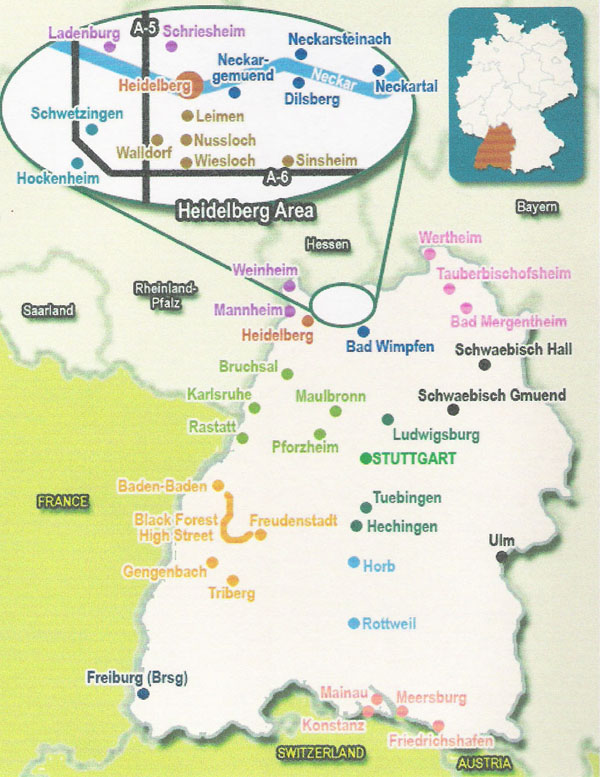
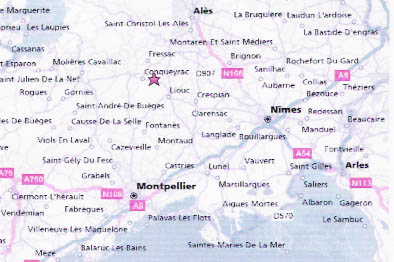
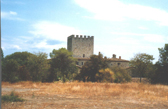
 possibly even in Spain.
possibly even in Spain. Protestant Movement with leanings towards the Huguenots. Persecution
during this period resulted in violent death for tens of thousand of
people and scattered refugees from France and Germany into Holland and
many other places of refuge. [He fled France with his family in
1685,when King Louis XIV, revoked the Edict of Nantes, and resumed the
persecution of protestants, ordering all Huguenot clergymen, to leave
France in fourteen days.]
Protestant Movement with leanings towards the Huguenots. Persecution
during this period resulted in violent death for tens of thousand of
people and scattered refugees from France and Germany into Holland and
many other places of refuge. [He fled France with his family in
1685,when King Louis XIV, revoked the Edict of Nantes, and resumed the
persecution of protestants, ordering all Huguenot clergymen, to leave
France in fourteen days.] France in fourteen days, Rev. Jean Ranc, then forty four years of
age, fled with his family from Paris to escape the death which would
undoubtedly have been their lot. When the persecution of the Huguenots
resumed with bitter vengeance, La Rochelle no longer existed as a haven
and there was little political or military power to restrain the vengeful
King. Rev. Jean Ranc, with his wife and son Hans Valentine, fled
first to the Alsatian city of Strasburg on the Rhine. It was not long
until the armies of Louis recaptured that city, which throughout
its history was sometimes German and sometimes French territory. The
refugees had to flee even farther down the Rhine to Mannheim. The Rev. died in Mannheim. There
is some validity to connect him with Bernadin du Ranc, Seigneur de Vibrac
but it is impossible to make a direct connection other than to suggest
that he was the younger son, cadet, who did not inherit the title."
France in fourteen days, Rev. Jean Ranc, then forty four years of
age, fled with his family from Paris to escape the death which would
undoubtedly have been their lot. When the persecution of the Huguenots
resumed with bitter vengeance, La Rochelle no longer existed as a haven
and there was little political or military power to restrain the vengeful
King. Rev. Jean Ranc, with his wife and son Hans Valentine, fled
first to the Alsatian city of Strasburg on the Rhine. It was not long
until the armies of Louis recaptured that city, which throughout
its history was sometimes German and sometimes French territory. The
refugees had to flee even farther down the Rhine to Mannheim. The Rev. died in Mannheim. There
is some validity to connect him with Bernadin du Ranc, Seigneur de Vibrac
but it is impossible to make a direct connection other than to suggest
that he was the younger son, cadet, who did not inherit the title."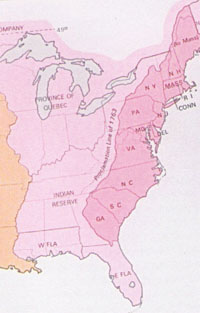 3. John Michael3 Ranck (Hans Valentine2,
Jean Valentine Ranc)
was born October 28, 1701 in Neckarau, near Mannheim, Baden, Germany, and
died July 28, 1778 in East Earl Twp., Lancaster Co., PA. He was buried
August 1, 1778, in the Ranck Family Cemetery. He immigrated August
24, 1728, Pennsylvania. He married Anna Barbara Schwab,
daughter of Hans Schwab and Anna Hammer. She was born Abt. 1708 in Leiman,
Heidleberg, Baden, Germany, and died 1784.
3. John Michael3 Ranck (Hans Valentine2,
Jean Valentine Ranc)
was born October 28, 1701 in Neckarau, near Mannheim, Baden, Germany, and
died July 28, 1778 in East Earl Twp., Lancaster Co., PA. He was buried
August 1, 1778, in the Ranck Family Cemetery. He immigrated August
24, 1728, Pennsylvania. He married Anna Barbara Schwab,
daughter of Hans Schwab and Anna Hammer. She was born Abt. 1708 in Leiman,
Heidleberg, Baden, Germany, and died 1784.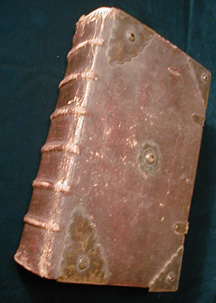
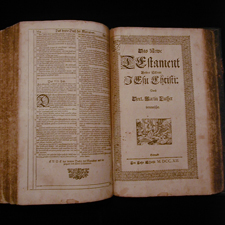
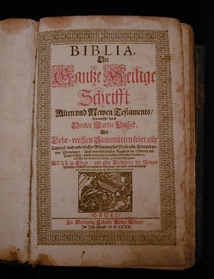
 neighborhoods. On occasion John Michael took his young family to the
Moravian congregation at Warwick (Lititz) where several of the children
were baptized and received into the various choirs (classes) of the
congregation. John Philip associated himself with the Zeltenreich's
Reformed Church five miles to the southwest. At the first Reformed Coetus
held in Philadelphia in 1747 Zeltenreich's was represented by Rev. John
Bartholomew and Elder Philip Ranck. The records of Trinity Lutheran Church
in New Holland also contain evidence of some ministerial acts performed
there for members of the family.
neighborhoods. On occasion John Michael took his young family to the
Moravian congregation at Warwick (Lititz) where several of the children
were baptized and received into the various choirs (classes) of the
congregation. John Philip associated himself with the Zeltenreich's
Reformed Church five miles to the southwest. At the first Reformed Coetus
held in Philadelphia in 1747 Zeltenreich's was represented by Rev. John
Bartholomew and Elder Philip Ranck. The records of Trinity Lutheran Church
in New Holland also contain evidence of some ministerial acts performed
there for members of the family.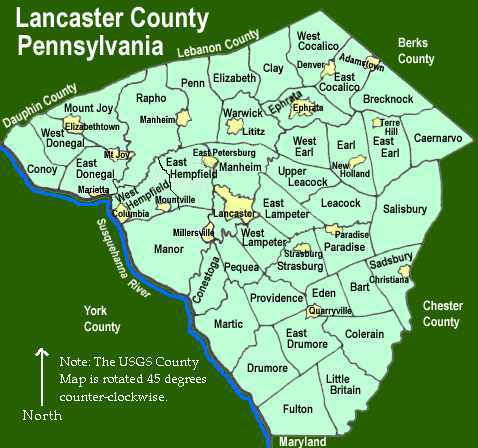
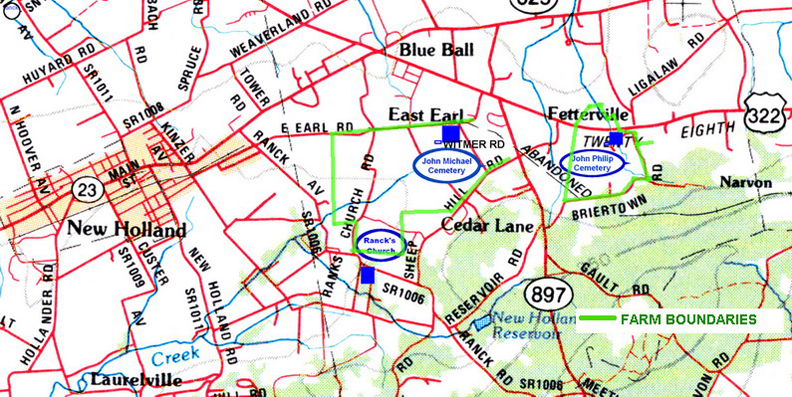


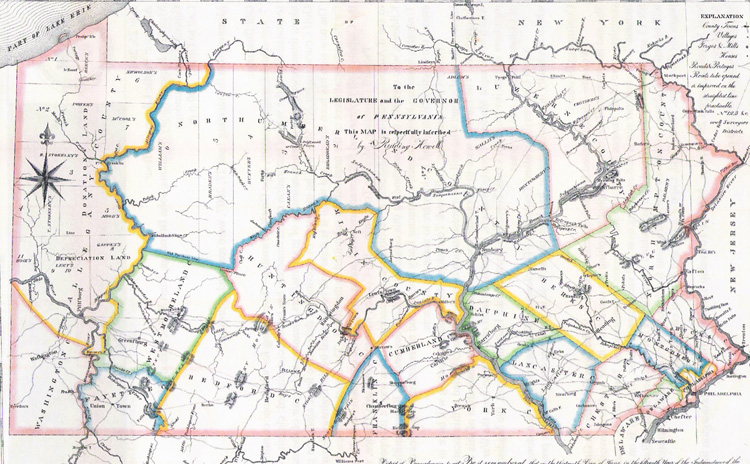
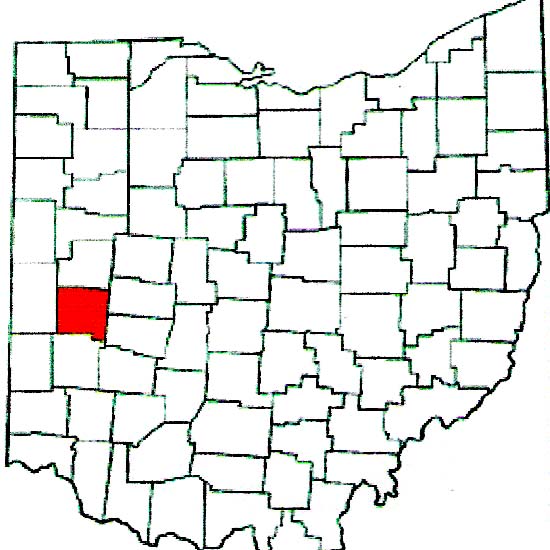 e moved to Miami County,
OH, with six of his seven children. One daughter, Eva, born after 1790 had
married Abraham Ery (Eby) and stayed in Bedford County, PA. George then
married a Miss Mary Nisonger (Niswonger) in 1820 and died shortly thereafter.
e moved to Miami County,
OH, with six of his seven children. One daughter, Eva, born after 1790 had
married Abraham Ery (Eby) and stayed in Bedford County, PA. George then
married a Miss Mary Nisonger (Niswonger) in 1820 and died shortly thereafter.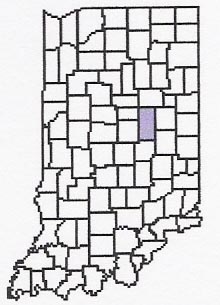 marriages of young people who were to be sent out as missionaries
to the Indians. The evangelization of the Indians was one of
the chief purposes of the Moravian colonists and must not be
delayed. The records of the Moravian Historical Society tell
the quaint story of the marriage of Anna Maria.
marriages of young people who were to be sent out as missionaries
to the Indians. The evangelization of the Indians was one of
the chief purposes of the Moravian colonists and must not be
delayed. The records of the Moravian Historical Society tell
the quaint story of the marriage of Anna Maria.
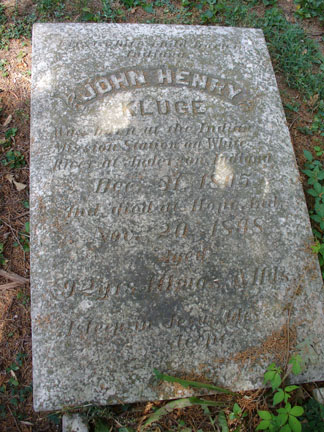
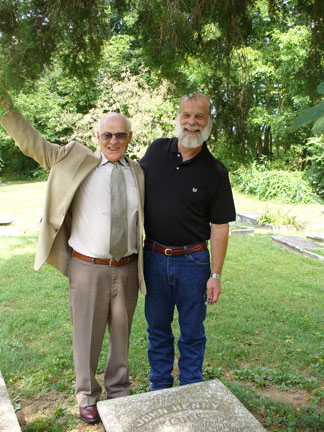
 married Margaretha Zimmerman. She was born 1611 in Sinsheim, Germany, and
died March 27, 1695 in Sinsheim, Germany. **(See map at top of
this page.)**
married Margaretha Zimmerman. She was born 1611 in Sinsheim, Germany, and
died March 27, 1695 in Sinsheim, Germany. **(See map at top of
this page.)**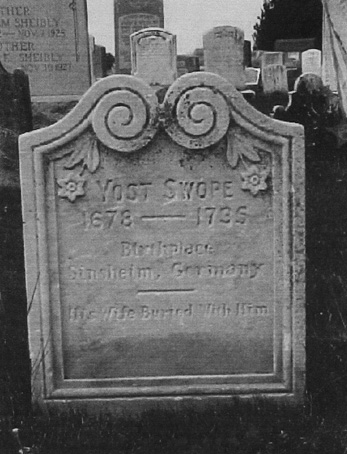
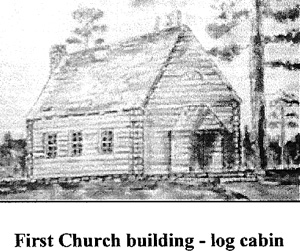
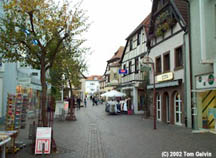 Sinsheim, and Margarethine born
Zimmerman. Jost had a brother Georg, born in 1659, and another brother,
George Albrecht, who was a baker (Jost was also a baker) and seminary
director at Sinsheim. He had also a sister whose name is unknown, who had
a child, Anna Christina, born in 1678. Georg Schwab, father of Jost, is
thought to have been the brother of another Jost Schwab, the mayor of
Sandhausen, a village which was part of the parish of Leimen in 1700.
Sinsheim, and Margarethine born
Zimmerman. Jost had a brother Georg, born in 1659, and another brother,
George Albrecht, who was a baker (Jost was also a baker) and seminary
director at Sinsheim. He had also a sister whose name is unknown, who had
a child, Anna Christina, born in 1678. Georg Schwab, father of Jost, is
thought to have been the brother of another Jost Schwab, the mayor of
Sandhausen, a village which was part of the parish of Leimen in 1700.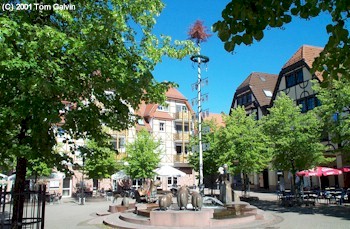 a Maria, married the
widower Andreas Meixel, 19 September 1719. The marriage record states,
'Anna Maria is the legitimate, single daughter of Jost Schwab, citizen and
baker at Leimen,' as though he were still living there.
a Maria, married the
widower Andreas Meixel, 19 September 1719. The marriage record states,
'Anna Maria is the legitimate, single daughter of Jost Schwab, citizen and
baker at Leimen,' as though he were still living there.